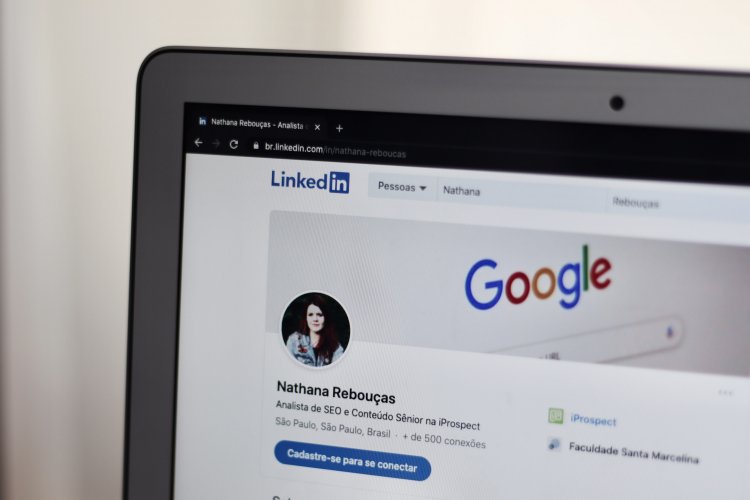LinkedIn may become a great partner in long-term branding and career management if you have a smart profile and a well-honed strategy.
Personal branding has only recently become increasingly relevant. Personal branding was once thought to be better left to athletes, models, and Hollywood superstars. We used to believe that only prominent individuals like Arnold Schwarzenegger, Donald Trump, Angela Merkel, Bruce Lee, Jennifer Lopez, and Kim Kardashian were entitled to a personal brand. What about the rest of us? We all have a personal brand, believe it or not. We have a personal brand if we have any form of social media or online presence, if we have mutual relationships with each other, with our family, friends, and coworkers. “Your brand is what other people say about you when you’re not in the room,” remarked Jeff Bezos.
To establish your brand, you must have a strong internet presence. What image do you wish to project? Ascertain that your LinkedIn profile and activity reflect this. LinkedIn is a fantastic tool for establishing and maintaining professional relationships throughout your career. However, you should consider what your profile says about you and whether it is compatible with how you want to be perceived when building your personal brand on LinkedIn. It’s critical to keep active on LinkedIn by engaging with others and sharing material, but first, make sure you have the fundamentals in place so you can create your brand properly. Many areas of your LinkedIn profile can be improved and should be updated regularly.
Is Linkedin Even Good For Personal Branding?
If you only have time to invest in one personal branding tool, make it LinkedIn. LinkedIn may become a great partner in long-term branding and career management if you have a smart profile and a well-honed strategy.
1. It’s Your Agent
LinkedIn makes you noticeable to decision-makers who are looking for exactly the services you provide, just like a seasoned team of promoters (without the charge!). Your LinkedIn profile, which is filled with the proper keywords, links you with people who are looking for what you must provide. You never know who might be looking for you, but a profile chock-full of relevant search terms can help you find them. It’s what I refer to as “planned serendipity.” You want to make yourself available to all prospective opportunities, particularly those you weren’t aware of. Branching out into a new area is when true growth occurs.
2. It’s Your 24/7 Billboard
Your LinkedIn profile is often the first impression a prospect gets of you when you aren’t there. Even if someone is searching for you on Google, they are likely to end up on your LinkedIn page. Because when someone searches your name on Google, LinkedIn usually comes up first, making your profile the most likely place for them to learn more about you.
3. It’s Your Professional Association
It allows you to connect with the right people and participate in the right conversations. You’ll find that you’ll need to connect with folks who share your knowledge and interests more and more. Because the world of work moves so quickly, you must be proactive to keep up with advances in your field of thought leadership. LinkedIn groups make it easy for you to participate in specialized discussions, allowing you to stay current and contribute more than you could with your local professional association.
4. It’s Your Website And Personal Blog.
LinkedIn allows you to show off your knowledge and express your opinions. It’s not all about achievements. It’s all about your distinct viewpoint. You boost your brand by sharing your opinions in a personal way with connections and others who visit your profile, from the way you write your description to the information you share in your activity feed, the groups you join, and the discussions you have.
How Do I Improve My Personal Brand On Linkedin?
1. Profile Picture
On LinkedIn, you must have a professional photo of yourself! This may seem self-evident, but you’d be astonished how many people fail to do so. Because your headshot is your initial impression, make sure it’s a professional portrait of yourself that’s in focus and well-lit. If you want your pictures to indicate that you’re serious about your work, dress accordingly. At the same time, it’s fine if you want to be a little less formal and more informal.
Photographs that are grainy or have bad lighting, group photographs, photographs that do not show your face, wedding photographs, photographs of your pet, and others should all be avoided. Those aren’t going to work. You can use a basic graphic or picture that suits the dimensions of your banner image. Feel free to use your imagination. However, neither your headshot nor your banner image should reveal your workplace. It’s all about establishing and sustaining your unique brand. That works well if you want the photographs to reflect the industry you operate in or your personality. Remember that developing your brand is about becoming known for what you do rather than being known as someone who works for a specific firm.
2. Title And Summary
When it comes to your LinkedIn bio, too many people leave the summary section blank, even though it is one of the most crucial components. It’s your chance to tell your visitors who you are, what you do, what sets you apart, and what your long-term goals are. It’s vital to fill this out, but don’t use it as a recap of your experience. That information is already included in the experience section. Also, your LinkedIn title should not be the same as your employment title. Write a short statement that encapsulates your passions and what you do for the title. It’s usually a good idea to keep keyword words and search terms in mind when writing your title and summary.
Consider your target audience when drafting your synopsis. Explain why you started doing what you do and what you enjoy about it. It’s also crucial to explain what sets you apart and what you offer to the table. Highlight your accomplishments and, if possible, offer stats on specific areas where you’ve assisted in improving. A social media marketer, for example, might outline the brand accounts they manage, the level of reach and engagement they helped these accounts achieve, and the tactics they prefer to employ. This isn’t needed, but it does assist the reader to comprehend how reliable you are.
Do not treat the summary as though it were a cover letter. You want to be true to yourself. Write as you speak, and don’t be afraid to mention any hobbies or interests you have outside of work. LinkedIn summaries can be difficult to write, and even the best writers struggle to write about themselves. Just keep in mind that you can change and amend your summary at any time. Rewriting is the best kind of writing, and none of this is fixed in stone.
3. Experience, Skills, And Education
In your LinkedIn profile, only include relevant employment experience that supports your brand. If you want people to think of you as an industry expert, for example, you should mention relevant work experience. Include any roles you’ve had, certificates you’ve achieved, accolades you’ve won, and accomplishments you think your target audience would be interested in. However, feel free to leave your side hustles off the list. Your target audience might not care about the summer you worked as a golf caddy or the fantasy football championships you won. When creating a personal brand, you want to project a certain image. Anything you can add to your profile to aid with this reputation should be included, but anything else that isn’t necessary should be removed.
Describe what you do for a living and the most critical tasks you complete. These must be related to the area of expertise in which you want to establish credibility and communicate to the target audience. Make an effort to be thorough while remaining concise. Add anything you think relevant to your skills when showcasing them, but have friends and coworkers endorse you and offer recommendations for your work. This section is crucial since it shows that other people enjoy working with you and have faith in your talents. Make sure to emphasize your schooling as well as any accolades or accomplishments you’ve received. It’s crucial to include if you were a member of a school organization or club.
4. Be Active! Share, and Engage With Others
Don’t only rely on search to locate individuals once you’ve spent time putting out your LinkedIn profile. You should update your LinkedIn profile regularly. Share useful material with your target audience, but don’t spam their feeds. It’s fantastic if you have a blog! People in your field will respect you if you promote it on LinkedIn. Promote yourself if you were recently featured on a podcast episode, or if you have a webinar or speaking engagement coming up. However, don’t constantly advertise yourself.
It’s also crucial to distribute content from other sources. This shows that you’re informed about your field and that you try to keep up with what’s going on. Post about what you’re witnessing in the industry, trends, and obstacles you’ve encountered, as well as how you overcame them. Your tales will be relatable to others in your field. It’s fantastic to start a conversation by sharing, but don’t forget to engage as well. Commenting on other people’s posts is a terrific way to make an initial connection with someone and can lead to further conversations. Simple things like “Wow, that was a great read!” “Thank you for sharing.” can make a big difference. Typing a thoughtful response that touches on the topic shared is an even better method to create and strengthen relationships on LinkedIn if you have the time.
How To Create Content For Personal Branding
1. Craft A Brand Mission Statement
All excellent content marketing strategies begin with a thorough understanding of the organization’s mission and goals. As a result, creating a personal brand goal statement is the first stage in your content marketing approach. a personal brand mission statement should include the following elements:
- Who you are.
- What you do.
- What do you stand for?
- What your unique value is.
2. Detail Your Brand’s Content Marketing Goals
Your content marketing can assist you in achieving your professional objectives (getting a raise, a new job, more clients, etc.), but they aren’t your content marketing objectives. Material marketing is the process of developing and disseminating content to attract and keep customers and, ultimately, to generate profitable action.
Consider the following personal content marketing objectives:
- Promote your brand: Get your name out there.
- Build brand trust: Assist consumers in seeing you as a valued and trustworthy resource.
- Deeper brand loyalty: Reach out to consumers on a more personal basis (e.g., signing up for your newsletter, sharing your content).
- Attract strategic partners: Create an environment where people want to support you (and them) (e.g., guest blogging and conference speaking).
3. Set Measurable Goals
You should add numbers and dates to your content marketing goals now that you’ve established your purpose, audience, content types, and frequency. If your content marketing aim is to increase brand trust, for example, your metric could be obtaining 50 newsletter subscribers in the following three months. It’s critical to link quantifiable goals to all your methods if you want to know how well your content is performing. One caveat: determining what reasonable quantitative targets to establish in the beginning can be difficult. This should not deter you from choosing them. Change your numbers if you discover they were unreasonable in your next evaluation. One of the benefits of building your brand is that there are no clients or managers to complain to about the change.












![[infographic]-free-marketing-automation-tools-that-are-a-great-help-to-marketers](https://www.marketinginasia.com/wp-content/uploads/2022/06/24897-infographic-free-marketing-automation-tools-that-are-a-great-help-to-marketers-150x150.png)




